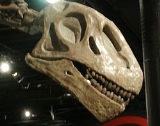
Omeisaurus
Encyclopedia
Omeisaurus is a genus
of sauropod dinosaur
from the Middle Jurassic
Period (Bathonian
-Callovian
stage) of what is now China
. Its name comes from Mount Emei
, where it was discovered in the lower Shaximiao Formation of Sichuan
Province.
 Like other sauropods, Omeisaurus was herbivorous and large. It measured 10 to 15.2 metres (30 to 50 ft) long, 4 metres (12 ft) high and weighed 4 ton
Like other sauropods, Omeisaurus was herbivorous and large. It measured 10 to 15.2 metres (30 to 50 ft) long, 4 metres (12 ft) high and weighed 4 ton
s.
Omeisaurus was first described in 1939. It was named after the sacred mountain Omeshian, which is were the first fossil example of Omeisaurus was found. Most skeletons of Omeisaurus were found in the 1970s and 1980s, during the great “Chinese Dinosaur rush”. There have been six species of Omeisaurus named so far: O. junghsiensis, O. changshouensis, O. fuxiensis, O. tianfuensis, O. luoquanensis, and O. maoianus. All of these but the last were named after the locations where they were found. O. fuxiensis was the smallest species, measuring around 35 feet (10.7 m) long. O. tianfuensis had the longest neck of the genus, around 30 feet (9.1 m) long. The only dinosaur with a longer neck was Mamenchisaurus
. A club tail fossil discovered in the same bone bed as the Omeisaurus fossils was thought to belong to this genus, but is now believed to belong to a large specimen of Shunosaurus
.
Mounted skeletons of Omeisaurus are on display at the Zigong Dinosaur Museum in Zigong
, Sichuan
Province and at Beipei Museum, near Chongqing
, both in China.
, but the two are based on different material despite having the same species name.
Omeisaurus is presently counted as a member of the Omeisauridae
, Mamenchisauridae
, or Euhelopodidae
. The general linkage of the genus with Mamenchisaurus
et al. is the basic theme of including it in the omeisaurid or mamenchisaurid families. However, Omeisaurus is similar to many non-mamenchisaurid Chinese eusauropods classified as euhelopodids.
Genus
In biology, a genus is a low-level taxonomic rank used in the biological classification of living and fossil organisms, which is an example of definition by genus and differentia...
of sauropod dinosaur
Dinosaur
Dinosaurs are a diverse group of animals of the clade and superorder Dinosauria. They were the dominant terrestrial vertebrates for over 160 million years, from the late Triassic period until the end of the Cretaceous , when the Cretaceous–Paleogene extinction event led to the extinction of...
from the Middle Jurassic
Middle Jurassic
The Middle Jurassic is the second epoch of the Jurassic Period. It lasted from 176-161 million years ago. In European lithostratigraphy, rocks of this Middle Jurassic age are called the Dogger....
Period (Bathonian
Bathonian
In the geologic timescale the Bathonian is an age or stage of the Middle Jurassic. It lasted from approximately 167.7 Ma to around 164.7 Ma...
-Callovian
Callovian
In the geologic timescale, the Callovian is an age or stage in the Middle Jurassic, lasting between 164.7 ± 4.0 Ma and 161.2 ± 4.0 Ma. It is the last stage of the Middle Jurassic, following the Bathonian and preceding the Oxfordian....
stage) of what is now China
China
Chinese civilization may refer to:* China for more general discussion of the country.* Chinese culture* Greater China, the transnational community of ethnic Chinese.* History of China* Sinosphere, the area historically affected by Chinese culture...
. Its name comes from Mount Emei
Mount Emei
"峨眉山" redirects here. For the county-level city that Mount Emei is located in, see Emeishan CityMount Emei is a mountain in Sichuan province, China...
, where it was discovered in the lower Shaximiao Formation of Sichuan
Sichuan
' , known formerly in the West by its postal map spellings of Szechwan or Szechuan is a province in Southwest China with its capital in Chengdu...
Province.

Ton
The ton is a unit of measure. It has a long history and has acquired a number of meanings and uses over the years. It is used principally as a unit of weight, and as a unit of volume. It can also be used as a measure of energy, for truck classification, or as a colloquial term.It is derived from...
s.
Omeisaurus was first described in 1939. It was named after the sacred mountain Omeshian, which is were the first fossil example of Omeisaurus was found. Most skeletons of Omeisaurus were found in the 1970s and 1980s, during the great “Chinese Dinosaur rush”. There have been six species of Omeisaurus named so far: O. junghsiensis, O. changshouensis, O. fuxiensis, O. tianfuensis, O. luoquanensis, and O. maoianus. All of these but the last were named after the locations where they were found. O. fuxiensis was the smallest species, measuring around 35 feet (10.7 m) long. O. tianfuensis had the longest neck of the genus, around 30 feet (9.1 m) long. The only dinosaur with a longer neck was Mamenchisaurus
Mamenchisaurus
Mamenchisaurus was a plant-eating four-legged dinosaur, known for its remarkably long neck which made up half its total length. It is known from numerous species which ranged in time from 160 to 145 million years ago, from the Oxfordian to Tithonian ages of the late Jurassic Period of...
. A club tail fossil discovered in the same bone bed as the Omeisaurus fossils was thought to belong to this genus, but is now believed to belong to a large specimen of Shunosaurus
Shunosaurus
Shunosaurus, meaning "Shu Lizard", is a genus of sauropod dinosaur from Middle Jurassic beds in Sichuan Province in China, 170 million years ago...
.
Mounted skeletons of Omeisaurus are on display at the Zigong Dinosaur Museum in Zigong
Zigong
Zigong , ancient name Ziliujing and Gongjing, is a prefecture-level city and the third largest city in Sichuan Province, in southwest China.-Geography:...
, Sichuan
Sichuan
' , known formerly in the West by its postal map spellings of Szechwan or Szechuan is a province in Southwest China with its capital in Chengdu...
Province and at Beipei Museum, near Chongqing
Chongqing
Chongqing is a major city in Southwest China and one of the five national central cities of China. Administratively, it is one of the PRC's four direct-controlled municipalities , and the only such municipality in inland China.The municipality was created on 14 March 1997, succeeding the...
, both in China.
Classification
It was once classified as a member of the Cetiosauridae family, which had long been a wastebasket taxon. The species O. fuxiensis is sometimes confused with ZigongosaurusZigongosaurus
Zigongosaurus is a genus of sauropod dinosaur from the Middle Jurassic-Late Jurassic-age Shaximiao Formation of Zigong, Sichuan, China...
, but the two are based on different material despite having the same species name.
Omeisaurus is presently counted as a member of the Omeisauridae
Omeisauridae
Omeisauridae is a family of sauropods. Wilson, when naming the family in 2002, included Omeisaurus and Mamenchisaurus, but if Mamenchisaurus is included, Mamenchisauridae has priority, as it was named in 1972...
, Mamenchisauridae
Mamenchisauridae
Mamenchisauridae is an extinct family of sauropod dinosaurs. The family was first named by Chinese paleontologists C.C. Young and H.C. Chao in 1972, in a paper describing Mamenchisaurus. Other mamenchisaurids may include Bellusaurus, Chuanjiesaurus, Eomamenchisaurus, Hudiesaurus, Klamelisaurus,...
, or Euhelopodidae
Euhelopodidae
Euhelopodidae is a family of sauropod dinosaurs which includes the genus Euhelopus. The family name was first proposed by American paleontologist Alfred Sherwood Romer in 1956. The four genera Chiayusaurus, Omeisaurus, Tienshanosaurus, and Euhelopus were the original proposed euhelopodines...
. The general linkage of the genus with Mamenchisaurus
Mamenchisaurus
Mamenchisaurus was a plant-eating four-legged dinosaur, known for its remarkably long neck which made up half its total length. It is known from numerous species which ranged in time from 160 to 145 million years ago, from the Oxfordian to Tithonian ages of the late Jurassic Period of...
et al. is the basic theme of including it in the omeisaurid or mamenchisaurid families. However, Omeisaurus is similar to many non-mamenchisaurid Chinese eusauropods classified as euhelopodids.
External links
- Omeisaurus in The Dinosaur Encyclopaedia at Dino Russ's Lair.

